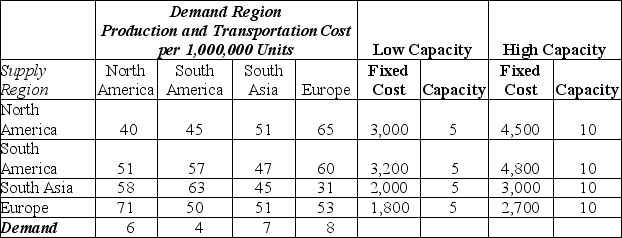Multiple Choice
Future Plastics manufactures plastic products for industrial use worldwide. In order to meet demand, they are considering setting up a facility in each region in order to lower transportation cost and to possibly avoid duties that could be imposed if the product is imported from another region. The disadvantage of this approach is that plants are sized to meet local demand and may not fully exploit economies of scale. Therefore, Future Plastics is also interested in determining the appropriate size of the facility to build in each location and are choosing between facilities with capacities of 5 or 10 million.
The fixed costs of each facility as well as the cost of shipping between regions is shown in the table below. The decision variables are defined as follows:
Xij = quantity shipped from supply region i to demand region j. i = 1, 2, 3, 4 and j = 1, 2, 3, 4.
Yik = 1 if facility k is selected for supply region i; 0 otherwise, where i = 1, 2, 3, 4 for each supply region; k = 1 (low capacity facility) or 2 (high capacity facility)

-Which of these constraints will ensure that either a low capacity or a high facility capacity facility is built in the European supply region?
A) Y41 + Y42 = 1
B) Y41 + Y42 ? 1
C) Y14 + Y24 = 1
D) Y14 + Y24 ? 1
Correct Answer:

Verified
Correct Answer:
Verified
Q37: The branch and bound solution method cannot
Q73: The Wiethoff Company has a contract
Q74: _ variables are best suited to be
Q75: Consider a capital budgeting example with five
Q76: The Wiethoff Company has a contract
Q78: In a 0-1 integer programming model, if
Q79: ...............
Q80: In a problem involving capital budgeting applications,
Q81: The divisibility assumption is violated by integer
Q82: The Exorbitant Course Fees. The $75